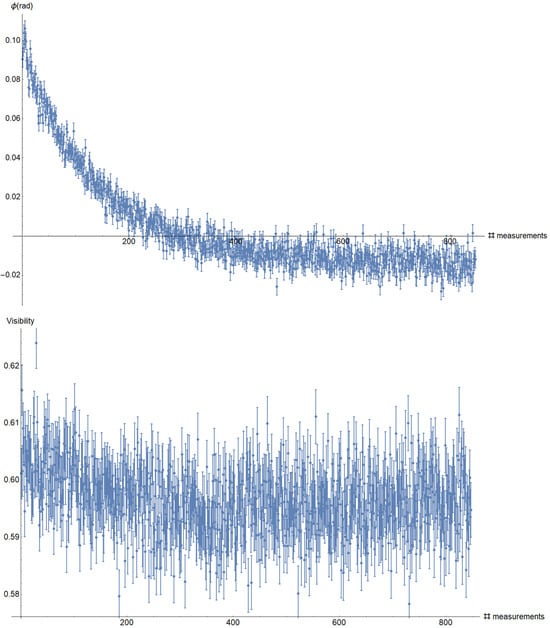Abstract
We have applied techniques of quantum phase estimation to the dynamical tracking of the optical activity of a solution of sucrose undergoing acid hydrolysis. We adopt a multiparameter approach that makes the estimation reliable and robust against setup instabilities.
Quantum metrology techniques have been extensively adopted to perform static measurements in many scenarios [1,2]. Phase estimation has been particularly studied [3,4,5], and it has been shown that the precision of such measurements can be drastically improved in multiparamter scenarios when exploiting correlations [6,7].
Due to the requirements of the measurement techniques, current quantum technologies are limited to sub-second time scales. These time scale however are quite interesting as they encompass a wide range of chemical and biological reactions, and more specifically those which can be monitored by a chirality alteration [8]. Furthermore, while intense illumination can be detrimental to samples especially of biological nature, the so called opticution [9,10], measurements performed with quantum light could be the natural go-to for biological dynamical reactions.
Here we report on a preliminary experiment on dynamical multiparameter estimation of the optical activity in the acid hydrolysis of sucrose [11,12]. When an aqueous solution of sucrose is mixed with hydrochloric acid (HCl) the latter acts as a catalyst for the hydrolysis of sucrose. This results in a solution of the sugar monomers glucose and fructose. While sucrose and glucose are dexorotatory, fructose is levorotatory and its optical power is greater than that of glucose (for Glucose, = 52.7, while for Fructose = –92.3, with a similar ratio in the near-IR wavelength range). Hence, we expect a change in the chirality of the solution from dexorotatory before the reaction to an overall levorotatory behaviour when the reaction is completed.
To monitor the dynamic of the rotatory activity we use the multiparameter strategy proposed in [13]. The experimental setup is depicted in Figure 1: a photon pair is generated via Type I parametric down conversion (SPDC) from a CW laser with 80 mW power. The two phtons with orthogonal polarizations are combined on a polarising beam splitter so that a N00N state in the circular polarisation with N = 2 is obtained through Hong-Ou-Mandel interfernece [14]. The N00N state in the left and right polarisation mode reads:

Figure 1.
Experimental setup:single photons at 810 nm, generated via type-I SPDC from a -barium-borate (BBO, 3mm length) nonlinear crystal excited via a continuous-wave pump laser are sent through a half-wave plate (HWP1 at 0° and HWP2 at 45°) before interfering on a beam splitter (PBS1) and the N00N state generated is sent on the chiral sample. A wave plate (HWP3) and a second polarizer (PBS2) project the outcoming photons onto different polarizations.
The photons are then sent on the chiral sample which will impart a phase on the R polarisation, so that the state becomes:
The outcoming photons are then projected onto different polarisation to provide the measurements needed for the phase estimation. In a realistic case, the measured probabilities will also depend on the visibility of the modulations of Equation (2), which, if not correctly accounted for, would provide a bias to the phase estimation. In a dynamic scenario, where the visibility can change in time due to instabilities both of the sample and of the setup itself, monitoring the visibility thus becomes of paramount importance for reliably tracking the phase evolution of the sample.
We perform measurements over a time span of 6 hours. Each measurement (corresponding to four different settings with 2 s acquisition time) takes approximately 30 s to be performed, including delays due to the measurement process. The results are reported in Figure 2. The upper panel shows the phase in function of the number of subsequent measurements, i.e., in function of time. As expected the behaviour of the optical activity of the sample changes from dexorotatory to levorotatory after the reaction is completed. Note that the visibility is indeed varying during the reaction, hence a single-parameter measurement would have led to a biased estimation over time.

Figure 2.
Experimental results: (upper panel) behaviour of the optical activity of the sucrose solution in time. (lower panel) visibility behaviour in time. The error bars are obtained with standard deviation.
Author Contributions
V.C., I.G., M.S., E.R., L.M. have built the setup, L.R. and T.G. have prepared the samples, V.C., I.G., M.S., L.R., T.G., M.G.G. have analyzed the data, D.T., M.A.R., F.B., M.B. have conceived and supervised the project, I.G. and M.B. have written the manuscript.
References
- Giovannetti, V.; Lloyd, S.; Maccone, L. Quantum-Enhanced Measurements: Beating the Standard Quantum Limit. Science 2004, 306, 1330–1336. [Google Scholar] [CrossRef] [PubMed]
- Giovannetti, V.; Lloyd, S.; Maccone, L. Quantum Metrology. Phys. Rev. Lett. 2006, 96, 010401. [Google Scholar] [CrossRef] [PubMed]
- Paris, M.G.A. Quantum estimation for quantum technology. Int. J. Quantum Inf. 2009, 7, 125–137. [Google Scholar] [CrossRef]
- Giovannetti, V.; Lloyd, S.; Maccone, L. Advances in quantum metrology. Nat. Photonics 2011, 5, 222–229. [Google Scholar] [CrossRef]
- Demkowicz-Dobrzanski, R.; Jarzyna, M.; Kolodynski, J. Quantum limits in optical interferometry. Prog. Opt. 2015, 60, 345–435. [Google Scholar] [CrossRef]
- Vidrighin, M.D.; Donati, G.; Genoni, M.G.; Jin, X.M.; Kolthammer, W.S.; Kim, M.S.; Datta, A.; Barbieri, M.; Walmsley, I.A. Joint estimation of phase and phase diffusion for quantum metrology. Nat. Commun. 2014, 5. [Google Scholar] [CrossRef] [PubMed]
- Roccia, E.; Gianani, I.; Mancino, L.; Sbroscia, M.; Somma, F.; Genoni, M.G.; Barbieri, M. Entangling measurements for multiparameter estimation with two qubits. Quantum Sci. Technol. 2018, 3. [Google Scholar] [CrossRef]
- Tischler, N.; Krenn, M.; Fickler, R.; Vidal, X.; Zeilinger, A.; Molina-Terriza, G. Quantum optical rotatory dispersion. Sci Adv. 2016, 2, e1601306. [Google Scholar] [CrossRef] [PubMed]
- Ashkin, A.; Dziedzic, J.; Yamane, T. Optical trapping and manipulation of single cells using infrared laser beams. Nature 1987, 330, 769–771. [Google Scholar] [CrossRef] [PubMed]
- Da silva, N.S.; Portich, W. Effect of GaAlAs laser irradiation on enzyme activity. Photomed. Laser Surg. 2010, 28, 3. [Google Scholar] [CrossRef] [PubMed]
- Schoebel, T.; Labuza, S.R.T.T.P. Reaction at Limited Water Concentration 1. Sucrose Hydrolysis. J. Food Sci. 1969, 34, 4. [Google Scholar] [CrossRef]
- Tombari, E.; Salvetti, G.; Ferrari, C.; Johari, G.P. Kinetics and Thermodynamics of Sucrose Hydrolysis from Real-Time Enthalpy and Heat Capacity Measurements. J. Phys. Chem. B 2007, 111, 496–501. [Google Scholar] [CrossRef] [PubMed]
- Roccia, E.; Cimini, V.; Sbroscia, M.; Gianani, I.; Ruggiero, L.; Mancino, L.; Genoni, M.G.; Ricci, M.A.; Barbieri, M. Multiparameter approach to quantum phase estimation with limited visibility. Optica 2018, 5, 1171–1176. [Google Scholar] [CrossRef]
- Hong, C.K.; Ou, Z.Y.; Mandel, L. Measurement of subpicosecond time intervals between two photons by interference. Phys. Rev. Lett. 1987, 59, 2044–2046. [Google Scholar] [CrossRef] [PubMed]
© 2019 by the authors. Licensee MDPI, Basel, Switzerland. This article is an open access article distributed under the terms and conditions of the Creative Commons Attribution (CC BY) license (https://creativecommons.org/licenses/by/4.0/).